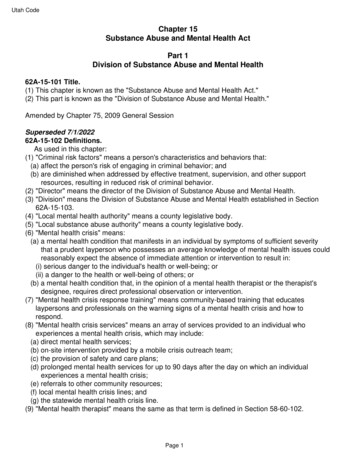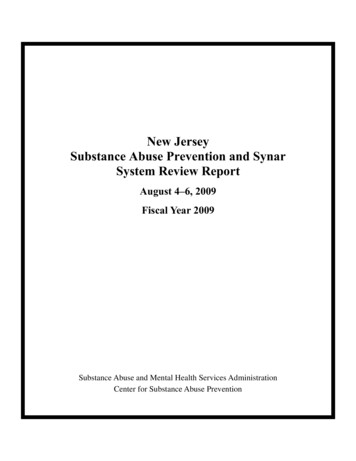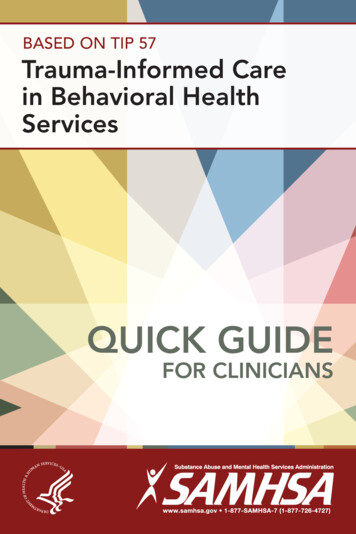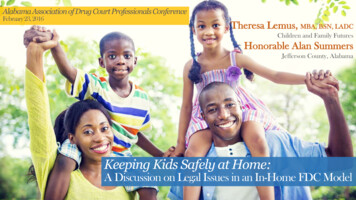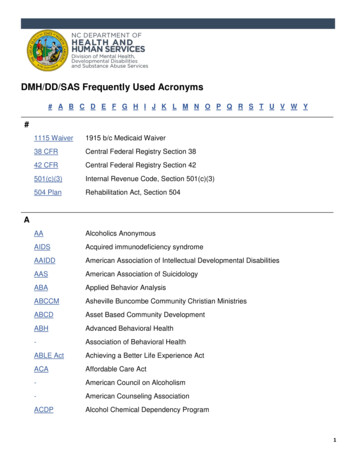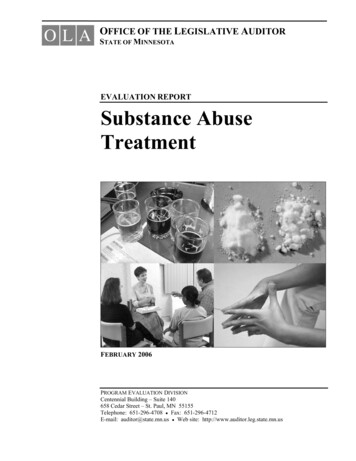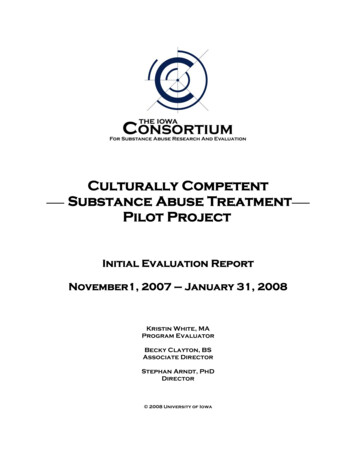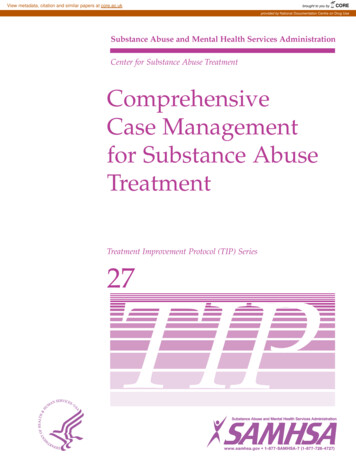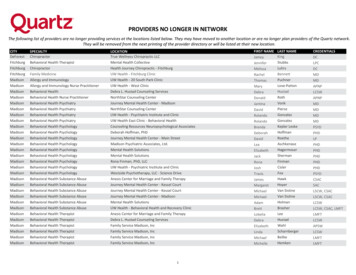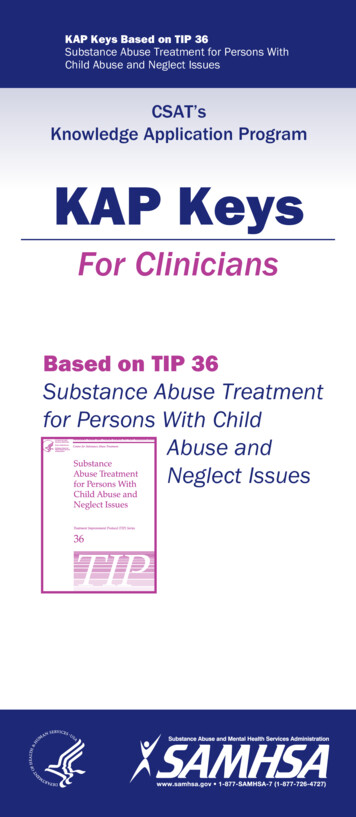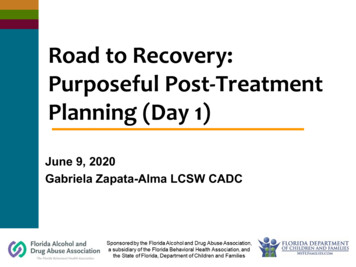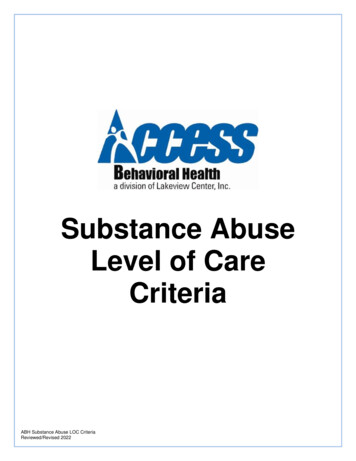
Transcription
Substance AbuseLevel of CareCriteriaABH Substance Abuse LOC CriteriaReviewed/Revised 2022
SUBSTANCE ABUSE LEVEL OF CARE CLINICAL CRITERIATable of ContentsSUBSTANCE ABUSE PREVENTION: Adult. 3OPIOID MAINTENANCE THERAPY: Adult . 4SUBSTANCE ABUSE INTERVENTION: Adolescent . 9SUBSTANCE ABUSE INTERVENTION: Adult . 12SUBSTANCE ABUSE OUTPATIENT: ADOLESCENT . 15SUBSTANCE ABUSE OUTPATIENT: Adult . 19SUBSTANCE ABUSE INTENSIVE OUTPATIENT: Adolescent . 24SUBSTANCE ABUSE INTENSIVE OUTPATIENT: Adult . 29SUBSTANCE ABUSE DAY OR NIGHT TREATMENT: Adolescent . 33SUBSTANCE ABUSE DAY OR NIGHT TREATMENT: Adult . 38SUBSTANCE ABUSE RESIDENTIAL TREATMENT LEVEL 1: Adult . 42SUBSTANCE ABUSE RESIDENTIAL TREATMENT LEVEL 2: Adolescent . 47SUBSTANCE ABUSE RESIDENTIAL TREATMENT LEVEL 2: Adult . 52SUBSTANCE ABUSE RESIDENTIAL TREATMENT LEVEL 3: Adult . 58SUBSTANCE ABUSE RESIDENTIAL TREATMENT LEVEL 4: Adult . 63SUBSTANCE ABUSE RESIDENTIAL TREATMENT LEVEL 5: Adult . 68SUBSTANCE ABUSE ADDICTIONS RECEIVING FACILITY: Adolescent . 70SUBSTANCE ABUSE ADDICTIONS RECEIVING FACILITY: Adult . 72SUBSTANCE ABUSE DETOXIFICATION: Adolescent . 74SUBSTANCE ABUSE DETOXIFICATION: Adult . 762
SUBSTANCE ABUSE LEVEL OF CARE CLINICAL CRITERIASUBSTANCE ABUSE PREVENTION: AdultPrevention services include activities and strategies that are used to prevent or impede the development orprogression of substance abuse problems. The services are directed toward the general population or specificsubpopulations, or toward individuals who are manifesting behavioral effects of specific risk factors forsubstance abuse.ADMISSION CRITERIA1. There is reasonable expectation that the individual or group can benefit from services at this level ofcareEXCLUSION CRITERIA1. The individual is assessed as needing a more intensive level of care and:a. Such a program is available to the individualb. Such a program is assessable to the individual2. The individual has medical impairments/conditions that renders treatment at this level of careineffective/unsafe3. The individual presents with emotional, behavioral or cognitive conditions and complications to a degreethat render treatment at this level of care ineffective/unsafeCONTINUED STAY CRITERIA1. The individual’s needs can not be better met by a higher level of care2. Continued intervention at this level of care is required to maintain the individual so that the risk ofneeding a higher level of service is reducedDISCHARGE CRITERIA1. Admission criteria for a higher level of care are met2. Maximum progress has been achieved3. The individual refuses to participate in services3
SUBSTANCE ABUSE LEVEL OF CARE CLINICAL CRITERIAOPIOID MAINTENANCE THERAPY: AdultMedication and Methadone maintenance treatment are nonresidential services which utilizes methadone orother approved medication in combination with clinical services to treat persons who are dependent upon opioiddrugs.ICD-10 DIAGNOSISF10.10 through F19.99ADMISSION CRITERIAMeets ASAM Criteria as outlined below:Client meets the criteria in dimensions one through six.Dimension 1: Acute Intoxication and /or Withdrawal PotentialIn this dimension, the client must meet (a) and (b), or one of (c), (d), or (e):a. A Physician determines that the client is “physiologically dependent upon an opiate drug and becamephysiologically dependent at least one year before admission to methadone maintenance.” This means that theclient was addicted “continuously or episodically for most of the year immediately before admission” (FDA 42CFR Part 8); andb. Criteria for determining the client’s current physiological dependence (in addition to a history of addiction)include but are not limited to vital signs, early physical signs of narcotic withdrawal, a urine screen that ispositive for opiates, the presence of old or fresh needle marks, and documented reports from medicalprofessionals, the client or family, treatment history, or (if necessary) a positive reactionto a naloxone test; orc. Clients admitted from penal or chronic care settings, if admitted within 14 days of release, or up to six monthsafter release without documented physiological dependence if the client was eligible for admission prior toincarceration (FDA 42 CFR Part 8); ord. Pregnant women who have a documented history of opiate dependence without physiological dependence ,if the program physician certifies that the woman is pregnant and finds that treatment is medically justified (FDA42 CFR Part 8); ore. Previously treated clients who are voluntarily detoxified from methadone within 2 years of discharge, in theabsence of current physiological dependence, if the program can document prior methadone treatment of 6months or more duration and, in the judgment of the program physician, readmission to OMT is medicallyindicated (FDA 42 CFR Part 8).Dimension 2: Biomedical Conditions and ComplicationsThe client’s status in this dimension is characterized by one of the following:a. The client meets the biomedical criteria for opiate dependence, with or without the complications of opiateaddiction, requiring medical monitoring and skilled care; orb. The client has a concurrent biomedical illness or pregnancy, which can be treated on an outpatient basis withminimal daily medical monitoring; orc. The client has biomedical conditions that can be managed on an outpatient basis, such as: (1) liver diseaseor problems with potential hepatic decompensation, (2) pancreatitis, (3) gastrointestinal problems, (4)cardiovascular disorders, (5) HIV and AIDS, (6) sexually transmitted diseases, (7) concurrent psychiatric illnessrequiring medications, and (8) tuberculosis.Dimension 3: Emotional, Behavioral or Cognitive Conditions and ComplicationsThe client’s status in this dimension is characterized by one of the following:a. The client’s emotional, behavioral or cognitive conditions, if present, are manageable in an outpatientstructured environment; orb. The client’s addiction-related abuse/neglect of the client’s spouse, children or significant others requireintensive outpatient treatment to reduce risk of further deterioration; orc. The client has diagnosed and stable emotional, behavioral or cognitive conditions or thought disorders (e.g.4
SUBSTANCE ABUSE LEVEL OF CARE CLINICAL CRITERIAstable borderline personality or obsessive-compulsive disorder) that require monitoring, management, and/ormedication because of the risks that these conditions will distract the client from a focus on treatment; ord. The client demonstrates a mild risk of posing harm to self or others, with or without a history of severedepression, suicidal and/or homicidal behavior, and can be managed safely in a structured outpatientenvironment; ore. The client demonstrates emotional/behavioral stability but requires continued pharmacology to preventrelapse to opiate use.Dimension 4: Readiness to ChangeThe client’s status in this dimension is characterized by one of the following:a. The client requires structured therapy, pharmacotherapy and programmatic milieu to promote treatmentprogress and recovery; orb. The client attributes problems to persons or external events rather that to the client’s addictive disorder. Thisinhibits the client’s ability to make behavior changes in the absence of clinically directed and repeatedstructured motivational interventions. However, the client’s resistance is not so high as to render treatmentineffective.Dimension 5: Relapse/ Continued Use PotentialThe client’s status in this dimension is characterized by one of the following:a. The client requires structured therapy, pharmacotherapy and programmatic milieu to promote treatmentprogress because the clientAttributes continued relapse to physiologic craving/need for opiates; orb. Despite active participation in other treatment interventions without provision for OMT, the client isexperiencing an intensification ofaddiction symptoms (e.g., difficulty postponing immediate gratification and related drug-seeking behavior) orcontinued high-riskbehaviors (e.g. shared needle use), and the individual’s level of functioning is deteriorating, despite revision ofthe treatment plan; orc. The client is at high risk of relapse to opiate use without OMT, and is in need of close outpatient monitoringand structured support, as indicated by lack of awareness or relapse triggers, difficulty in postponing immediategratification and/or ambivalence toward or resistance to treatment.Dimension 6:Recovery EnvironmentThe client’s status in this dimension is characterized by one of the following:a. A sufficiently supportive psychosocial environment makes OMT feasible (e.g., significant others aresupportive of recovery efforts, theclient’s workplace is supportive, the client is subject to legal coercion, the client has adequate transportation tothe program, etc.); orb. Family/significant others are supportive but require professional intervention to improve the client’s likelihoodof treatment success(e.g., assistance with limit-setting, communication skills, avoiding rescuing behaviors, education aboutmethadone treatment and HIVrisk avoidance, etc.); orc. The client does not have a positive social support system to assist with immediate recovery efforts, but he orshe has demonstratedmotivation to obtain such a support system or to pursue (with assistance) an appropriate alternative livingenvironment; ord. The client has experienced traumatic events in his or her recovery environment (such as physical, emotional,sexual or domestic abuse) or has manifested the effects of emotional/behavioral problems in the environment(such as criminal activity), but these are manageable on an outpatient basis.5
SUBSTANCE ABUSE LEVEL OF CARE CLINICAL CRITERIAEXCLUSION CRITERIA1.2.3.4.The individual has been dependent on an opiate for less than one yearThe individual refuses to consent to the required registry proceduresThe individual is known to be currently participating in this level of service with another providerThe physician after assessment of the individual determines that the individual would not benefit fromtreatment at this level of care5. The physician determines that treatment of the individual at this level of care poses a danger to theindividual, staff, or other individuals6. The individual has medical impairments/conditions that renders treatment at this level of careineffective/unsafe7. The individual presents with emotional, behavioral or cognitive conditions and complications to a degreethat render treatment at this level of care ineffective/unsafe8. The individual does not give voluntary consent for treatment9. The individual’s recovery environment is such that treatment at this level of care is not recommended10. The individual refuses agreement to follow program structure/rulesCONTINUED STAY CRITERIAMeets ASAM continued stay criteria as outlined below:Continued service requires the client meet the criteria of dimensions one through six.Dimension 1: Acute Intoxication and/or Withdrawal PotentialThe client’s status in this dimension is characterized by one of the following:a. The client requires continued opioid maintenance therapy to prevent his or her return to illicit opiate use; orb. The client evidences current use (or increased risk of use) of drugs other than opiates; orc. The client has a history of inability to abstain from opiate use, despite multiple attempts at detoxification.Dimension 2: Biomedical Conditions and ComplicationsThe client’s status in this dimension is characterized by one of the following:a. Biomedical conditions, if any, continue to be sufficiently stable to permit the client’s continued participation inoutpatient treatment; orb. The client evidences, or is at risk of a serious or chronic biomedical condition (such as HIV/AIDS,tuberculosis, etc.) that may be exacerbated by a return to illicit opiate useDimension 3: Emotional, Behavioral or Cognitive Conditions and ComplicationsThe client’s status in this dimension is characterized by one of the following:a. The client has achieved stable emotional, behavioral or emotional functioning, which may be jeopardized bydiscontinuation of opioid maintenance treatment; orb. The client demonstrates the potential for making use of OMT (as by participating in the program, attendingcounseling sessions, decreasing illicit activity, etc.) but has not yet made necessary life changes; orc. An emotional, behavioral or cognitive disorder, which is being concurrently managed, continues to distractthe client from focusing on treatment goals; however, the client is responding to treatment and, with furtherintervention, is expected to achieve treatment objectives; ord. The client continues to manifest behaviors that pose a risk to self or others (e.g., periodic needle-sharing,unprotected sexual contact, outside drug use, etc.), but the condition is improving; ore. Emotional, behavioral or cognitive complications of addiction are still present and are manageable in astructured outpatient environment but require continued therapeutic interventions. These behaviors may includeillicit drug use/criminal activity, involvement in domestic violence as a victim or perpetrator, or inability to keep ajob or maintain a stable household (e.g. provide for food, consistent shelter, supervision of children, and healthcare).Dimension 4: Readiness to ChangeThe client’s status in this dimension is characterized by one of the following:a. The client recognizes the severity of his or her drug problem but demonstrates minimal understanding of the6
SUBSTANCE ABUSE LEVEL OF CARE CLINICAL CRITERIAself-defeating nature of his/her substance abuse, however, the client is progressing in treatment; orb. The client recognizes the severity of his or her drug problem and demonstrates an understanding of the selfdefeating nature of such alcohol or other drug involvement; however, the client does not demonstrate behaviorsthat indicate the level of responsibility necessary to cope with the problem; orc. The client is beginning to accept responsibility for addressing his or her drug problem but still requires thislevel of intensity of motivational strategies to sustain progress in treatment; ord. The client has accepted responsibility for his or her drug problems and has determined that ongoingtreatment with OMT is the most effective means of preventing relapse.Dimension 5: Relapse/ Continued Use PotentialThe client’s status in this dimension is characterized by one of the following:a. The client continues to require structured therapy, pharmacotherapy and programmatic milieu to promotetreatment progress because the client attributes continued relapse to physiologic craving/need for opiates; orb. The client recognizes relapse triggers but has not developed sufficient coping skills to interrupt or postponegratification or to change inadequate impulse control behaviors; orc. The client’s addiction symptoms, while stabilized, have not been reduced sufficiently to support functioningoutside a structured milieu; ord. Pharmacotherapy has been a part of an effective treatment process that has alleviated addiction symptomsand prevented relapse, and the withdrawal of methadone or other medication is likely to lead to a recurrence ofaddiction symptoms.Dimension 6: Recovery EnvironmentThe client’s status in this dimension is characterized by one of the following:a. The client has not yet developed sufficient coping skills to withstand stressors in the work environment so asto prevent return to illicit opiate use and has not developed vocational alternatives; orb. The client has not yet developed sufficient coping skills to deal with non-supportive family/social environmentto prevent return to illicit opiate use and has not developed alternative support systems; orc. The client has not yet integrated the socialization skills necessary to establish a supportive social network; ord. Problem aspects of the client’s social and interpersonal life are responding to treatment, but are notsufficiently supportive of recovery to allow transfer to a less intensive level of care; ore. The client’s social and interpersonal life has not improved or has deteriorated and the client needs additionaltreatment to learn to cope with the current situation or to take steps to secure an alternative environment; orf. The client’s social and interpersonal life has stabilized while he/she has been in treatment and indicates theneed for continued OMT.DISCHARGE CRITERIAMeets ASAM discharge criteriaDischarge requires that the client meet the criteria in at least one of the six dimensions.Dimension 1: Acute Intoxication and/or Withdrawal PotentialThe client’s status in this dimension is characterized by one of the following:a. The client no longer requires OMT to prevent his or her return to illicit use of opiates or other drugs; orb. The client exhibits symptoms of severe intoxication and/or withdrawal, which can not be safely managed atthis level of care.Dimension 2: Biomedical Conditions and ComplicationsThe client’s status in this dimension is characterized by one of the following:a. The client’s biomedical conditions, if any, and opiate dependence problem have stabilized and can bemanaged without continuing OMT, and the client does not meet any of the continued service criteria thatindicate the need for further treatment; orb. The client’s biomedical condition has deteriorated, and the client requires continued treatment in a differenttreatment setting.Dimension 3: Emotional, Behavioral or Cognitive Conditions and Complications7
SUBSTANCE ABUSE LEVEL OF CARE CLINICAL CRITERIAThe client’s status in this dimension is characterized by one of the following:a. The client’s emotional, behavioral or cognitive problems have diminished or stabilized to the extent that theycan be managed through outpatient counseling or self-help fellowship without continued OMT, and the clientdoes not meet any of the continued service criteria that indicate the need for further treatment; orb. A psychiatric or emotional, behavioral or cognitive problem exists that is interfering with addiction treatment inan outpatient treatment setting, so that (1) continued participation in an OMT presents a serious psychiatric risk,as determined by the program’s medical director, and (2) continued treatment is required at a more intensivelevel of care.Dimension 4: Readiness to ChangeThe client’s status in this dimension is characterized by one of the following:a. The client’s awareness and acceptance of his or her addiction and commitment to recovery is sufficient toexpect maintenance of recovery through outpatient counseling or self-directed recovery plan, as evidence by(1) the client’s recognition of the severity of his/her drug problem, (2) the client’s demonstration of anunderstanding of the self-defeating nature of his/her alcohol/other drug use, (3) the client’s application of theessential skills necessary to maintain a stable recovery program without pharmacological supports at this time,and (4) the client does not meet any of the continued service criteria that indicate the need for furthertreatment; orb. The client consistently has failed to achieve essential treatment objectives, despite revisions to the treatmentplan, to the degree that the client needs placement at another level of care.Dimension 5: Relapse/ Continued Use PotentialThe client’s status in this dimension is characterized by one of the following:a. The client recognizes relapse triggers and has developed sufficient coping skills to interrupt or postponegratification and impulse control behaviors without continued OMT, and the client does not meet any of thecontinued service criteria that indicate the need for further treatment; orb. The client is experiencing a continuation or exacerbation of drug-seeking behaviors or craving that is notresponding to OMT and which has been determined to require a more intensive level of care.Dimension 6: Recovery EnvironmentThe client’s status in this dimension is characterized by one of the following:a. The client’s social system and significant others are supportive of recovery to the extent that the client canadhere to a self-directed recovery plan without substantial risk or relapse on discontinuation of OMT, and theclient does not meet any of the continued service criteria that indicate the need for further treatment; orb. The client’s social system remains non-supportive or has deteriorated. The client is having difficulty copingwith this environment and is at substantial risk of relapse. The client is unable to achieve essential treatmentobjectives within his/her current social environment.8
SUBSTANCE ABUSE LEVEL OF CARE CLINICAL CRITERIASUBSTANCE ABUSE INTERVENTION: AdolescentIntervention services are activities and strategies that are used to prevent or impede the development orprogression of substance abuse problems. Structured services are targeted toward individuals or groups at riskof substance abuse and focused on reducing those factors associated with the onset or early stages ofsubstance abuse, and related problems.ADMISSION CRITERIAMeets ASAM admission criteria for this level of care:Must meet one of Dimensions of 4, 5, or 6 and Dimensions 1, 2, and 3 are stable or being addressed throughappropriate outpatient medical or mental health services.Dimension 1: Acute Intoxication and /or Withdrawal PotentialThe client’s status in this dimension is characterized by one of the following:a. Client is free from intoxication or withdrawal symptoms/risks; orb. The client’s intoxication or withdrawal symptoms/risks can be managed at this level of care.Dimension 2: Biomedical Conditions and ComplicationsNone or very stable– Any biomedical conditions are stable or are being actively addressed and will not interferewith interventions at this level of care.Dimension 3: Emotional, Behavioral or Cognitive Conditions and ComplicationsNone or very stable - Any emotional, behavioral or cognitive conditions or complications are being addressedthrough appropriate mental health services and will not interfere with interventions at this level of service.Dimension 4: Readiness to ChangeWilling to understand how current use may affect personal goals – The client expresses willingness to gain anunderstanding of how his/her current use of alcohol and /or other drugs may interfere with meetingresponsibilities and achieving personal goals.Dimension 5: Relapse/ Continued Use PotentialNeeds understanding of, or skills to change current use patterns. The situation is characterized by one of thefollowing:a. The client does not understand the need to alter the current pattern of use of substances to prevent furtherharm related to such use; orb. The client needs to acquire the specific skills needed to change his/her current pattern of use.Dimension 6: Recovery EnvironmentSocial support system or significant others increase risk for personal conflict about alcohol/drug use. Theclient’s living environment is characterized by one of the following:a. The social support system is composed primarily of individuals whose substance use patterns prevent themfrom meeting social, work, school or family obligations ; orb. Family members currently are abusing substances, increasing the client’s risk for substance related disorder;orc. Significant others express values concerning alcohol or other drug use that create significant conflict for theclient; ord. Significant others condone or encourage inappropriate use of alcohol or other drugs.EXCLUSION CRITERIA1. The individual is assessed as needing a more/less intensive level of care and:a. Such a program is available to the individualb. Such a program is accessible to the individual2. There is no evidence that the individual is at risk of substance abuse3. The individual has medical impairments/conditions that would make treatment at this level of careineffective/unsafe4. The individual presents with emotional, behavioral or cognitive conditions and complications to a degree9
SUBSTANCE ABUSE LEVEL OF CARE CLINICAL CRITERIAthat render treatment at this level of care ineffective/unsafe5. The individual does not give voluntary consent for treatment at this level of care or there is no order totreatment for involuntary admissions pursuant to Florida Statutes, Chapter 3976. The individual’s recovery environment is such that treatment at this level of care is not recommended7. The individual/caregiver refuses agreement to follow program structure/rules to such a degree to rendertreatment at this level of care ineffective/unsafeCONTINUED STAY CRITERIAMeets ASAM continued stay criteria for this level of care:The client remains stable in Dimensions 1,2, and 3, and meets the criteria in at least one of Dimensions 4, 5, or6.Dimension 1: Acute Intoxication and/or Withdrawal PotentialClient is free from intoxication or withdrawal symptoms/risks.Dimension 2: Biomedical Conditions and ComplicationsNone or very stable– Any biomedical conditions are stable or are being actively addressed and will not interferewith interventions at this level of care.Dimension 3: Emotional, Behavioral or Cognitive Conditions and ComplicationsNone or very stable - Any emotional, behavioral or emotional conditions or complications are stable or are beingactively addressed and will not interfere with interventions at this level of care.Dimension 4: Readiness to ChangeWilling to understand how current use may affect personal goals – The client continues to express a willingnessto gain an understanding of how his/her current use of alcohol and /or other drugs may interfere with meetingresponsibilities and achieving personal goals.Dimension 5: Relapse/ Continued Use PotentialThe client demonstrates an understanding of the detrimental aspects of his/her alcohol and/or drug use patternbut does not yet demonstrate the skills necessary to change those patterns.Dimension 6: Recovery EnvironmentThe client’s living environment is characterized by one of the following:a. Problem aspects of the environment remain, but the client is acquiring the skills needed to cope with them; orb. Significant others who have documented problems with alcohol or other drug use are receiving help for theirproblems, which have not yet stabilized.DISCHARGE CRITERIAMeets ASAM discharge criteria for this level of care:Discharge from this level of care requires that the client meet the criteria in one of the six dimensions.Dimension 1: Acute Intoxication and/or Withdrawal PotentialThe client’s status in this dimension is characterized by one of the following:a. Client is free from intoxication or withdrawal symptoms/risks; orb. The client exhibits symptoms of severe intoxication and/or withdrawal, which can not be safely managed atthis level of care.Dimension 2: Biomedical Conditions and ComplicationsThe client’s status in this dimension is characterized by one of the following:a. The client has a condition in Dimension 2 that precludes continued participation in this level of care andrequires transfer to another level; orb. The client has no biomedical conditions or they are stable.Dimension 3: Emotional, Behavioral or Cognitive Conditions and ComplicationsThe client’s status in this dimension is characterized by one of the following:a. The client has a condition in Dimension 3 that precludes continued participation in this level of care andrequires transfer to another level; orb. The client has no emotional, behavioral or cognitive conditions or they are stable and are being actively10
SUBSTANCE ABUSE LEVEL OF CARE CLINICAL CRITERIAaddressed.Dimension 4: Readiness to ChangeThe client’s status in this dimension is characterized by one of the following:a. The client has remained stable in Dimension 4 and does not meet any other criteria that indicates theneed for continued service at this level of care; orb. The client is no longer willing to examine personal substance use patterns, despite program efforts, and arecommendation is being made for further assessment and follow-up.Dimension 5: Relapse/ Continued Use PotentialThe client’s status in this dimension is characterized by one of the following:a. The client has demonstrated the personal skills necessary to make responsible choices about alcohol/otherdrug use, and does not meet criteria indicating the need for continued service at this level of care; orb. The client has not integrated the skills necessary to avoid harmful or inappropriate substance use, despiteprofessional interventions, and a recommendation is being made for further assessment and follow-up.Dimension 6: Recovery EnvironmentThe client’s status in this dimension is characterized by one of the following:a. The client has resolved problems in his/her living environment or demonstrates the
SUBSTANCE ABUSE LEVEL OF CARE CLINICAL CRITERIA 4 OPIOID MAINTENANCE THERAPY: Adult Medication and Methadone maintenance treatment are nonresidential services which utilizes methadone or

